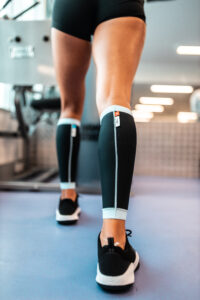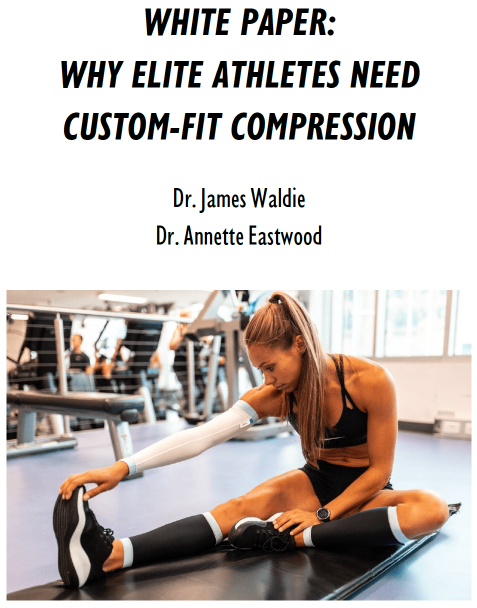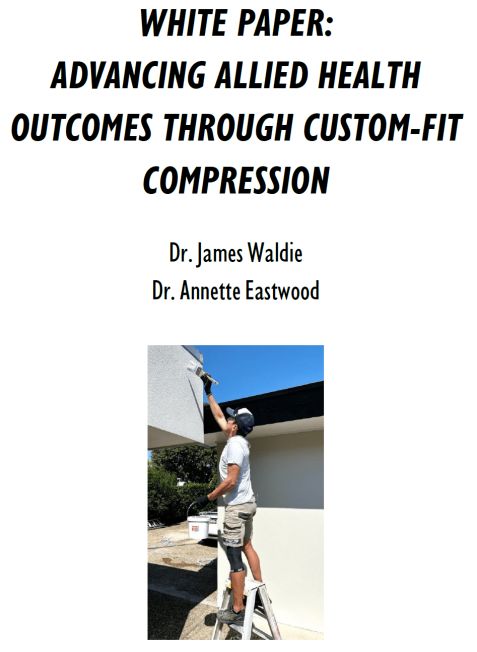Wearing a compression garment is a bit like getting a localised, encapsulating hug from an item of clothing! But how tight should that ‘hug’ be? Well, it turns out that pressure measurement underpins the science of solving that puzzle…

Direct pressure measurement
Direct pressure measurements typically involve placing some form of force or pressure sensor between the compression garment and the surface of the wearer’s skin (in the case of on-the-body measurements), or between the compression garment and the surface of the replica/model body or body part (in the case of off-the-body measurements); see Figure 1. In this way, we measure the force or pressure directly at the zone of interest and in the direction the compression itself is being applied. (For completeness, note that the details get murkier when we consider how a pressure sensor actually translates the pressure it experiences into a signal we can interpret, but we won’t get lost in the weeds on that one.)
The advantages of off-the-body measurements here include that all aspects of the testing or measurement process can be really well controlled and you can study aspects that are more difficult to do with real people. However, what you may gain in practicality and consistency of conditions, you typically lose in reflecting the natural variation in the size, shape, and underlying tissue properties of individual people. Therefore, a big advantage of on-the-body measurements is, of course, that this is the most faithful representation of real life!
Generally, the same sensors can be used for both on-the-body and off-the-body direct pressure measurements. Examples of these sensor types include thin-film force or pressure sensors and pneumatic (or air-filled) ‘bladders’ that are connected to pressure sensors. Thin-film force or pressure sensors have the benefit of being, well, thin (no surprises there, with ‘thin’ in the name!) and are typically made up by carefully layering and/or arranging special materials. These sensors are also more conducible to being used over a larger area to indicate pressure distribution. However, at the time of writing, commercially available versions of these sensors (or sensor arrays) tend to be less suitable for following the contours of the human body beneath compression garments when compared to pneumatic bladders/sensors. That said, lots of work is ongoing to advance this sort of technology and, like the strain sensors mentioned earlier, thin-film and related sensor types show promise for one day being integrated into clothing or onto the skin itself [2].
Pneumatic (air) pressure sensors generally consist of a pliable bladder connected to a separate measurement device by a hollow tube (airline). These bladders are then filled with some air and the pressure of the air in the bladder rapidly equalises with the pressure being applied to it by the compression garment (from above) and by the body (from below). As the theory goes (here we can thank another really old, again dead, French guy, this time by the name of Pascal), the air pressure in the bladder under the compression garment is faithfully transmitted along the airline to the pressure sensor in the accompanying device where the pressure is registered. There are some issues that arise from the thickness of the bladder when it has air in it but, in the context of medical and sports compression garments, these issues tend more important for the off-the-body measurements and less important for on the body measurements [3]. While pneumatic pressure sensors work well [4, 5], they are typically single-site measurements so, as alluded to above, it can get tricky if you want to know in detail what the local pressure distribution looks like (e.g. around the circumference of the leg).
Figure 1 – Salzmann leg and pneumatic sensors (left) and human leg with sensor attached (right).
Where to measure?
The pressures applied by compression garments can be measured anywhere, but it is important to note in sufficient detail the anatomical location at which the measurement takes place and the conditions of the test (including posture of the person being measured, and if they are stationary or moving, etc). Further, consideration needs to be given to the surface geometry, the properties of the underlying tissue (think of the difference between bone, muscle, and fat tissue), and how these interact with the method you are using to measure (or estimate) pressure. Unless you have good reason to do otherwise, a practical rule of thumb (for on-the-body measurements) is to use sites over soft tissue. An even better idea is to start with known standards or recommendations because this helps with consistency across the board. With substantial history of measuring compression of the lower limbs in the context of medical compression hosiery, clear recommendations are available for the lower body [6, 7], but this is not yet the case for the rest of the body. Keeping with the lower body here (in part, due to the popularity of lower-body compression garments for sport), perhaps the most obvious sites to use by default would be the area at which the Achilles tendon changes into the calf muscles (B1), the calf at its maximum girth (C), and the mid-thigh between patella and groin (F). The letter in the brackets here indicate the labelling convention used for these sites [7].
From Earth to Space, and back: cross-over of information
There is ambition for humans to not only return to the Moon, but also go beyond and explore the surface of Mars. For such surface exploration missions, the astronaut must be protected from the hostile local environment which includes a lack of atmospheric pressure in the case of the Moon and very low atmospheric pressure in the case of Mars. To date, all occasions in which an astronaut has left the protection of their pressurised spaceship or vehicle (e.g., during space walks out of the International Space Station, or during the Apollo missions to the Moon in the late 60s and early 70s), they have been wearing a gas-pressurised space suit. While gas-pressurised suits have functioned well in keeping their wearer alive, disadvantages include the lack of body mobility and dexterity and the increased energetic costs of performing tasks. For this reason, there is interest in using spacesuits that are instead more like a compression garment – think of it being like wearing a very, very tight full-body wetsuit. (In fact, the idea was being seriously explored already in the 1960s, with a guy named Paul Webb leading the charge.) The theory is that this type of suit will be lighter and much less cumbersome to move around in. However, there are several key challenges to overcome for a compression (or, ‘mechanical counter pressure’) spacesuit to be a feasible alternative to the traditional gas-pressurised suits. One of these challenges (surprise, surprise) is the measurement of the applied pressures. If the suit isn’t providing sufficient pressure to the astronaut’s body, then it is much better to know about that before exiting the safety of the spaceship! Here, work that advances the seamless integration of pressure sensors into compression garments here on Earth will have cross-over for benefiting pressure measurement in space, and vice versa. Think about that the next time you’re wearing your compression garments and catch a glimpse of the moon…
Provenance: This blog entry was written for CAPE Bionics by Dr. MacRae as part of a Human Aerospace science communication outreach, highlighting crossovers of knowledge and information between space-focussed and terrestrial-focussed industries and applications. This work was unpaid.
[1] MacRae BA, Laing RM, Partsch H (2016) General Considerations for Compression Garments in Sports: Applied Pressures and Body Coverage. In Engel F and Sperlich B (eds.) Compression Garments in Sports: Athletic Performance and Recovery. Springer International Publishing Switzerland, pp 1-32.
[2] He J, Zhang Y, Zhou R, Meng L, Chen T, Mai W, Pan C (2020) Recent advances of wearable and flexible piezoresistivity pressure sensor devices and its future prospects. Journal of Materiomics, 6(1), 86-101.
[3] Jariyapunya N, Musilová B (2019) Predictive modelling of compression garments for elastic fabric and the effects of pressure sensor thickness. The Journal of The Textile Institute, 110(8), 1132-1140.
[4] Nandasiri GK, Shahidi AM, Dias T (2020) Study of Three Interface Pressure Measurement Systems Used in the Treatment of Venous Disease. Sensors, 20(20), 5777.
[5] Brophy-Williams N, Driller MW, Halson SL, Fell JW, Shing CM (2014) Evaluating the Kikuhime pressure monitor for use with sports compression clothing. Sports Engineering, 17(1), 55-60.
[6] Partsch H, Clark M, Bassez S, Benigini JP, Becker F, et al. (2006) Measurement of lower leg compression in vivo: recommendations for the performance of measurements of interface pressure and stiffness. Dermatologic surgery, 32(2), 224-233.
[7] Comité Européen de Normalisation (2001) ENV 12718: Medical compression hosiery. Comité
Européen de Normalisation, Brussels.





